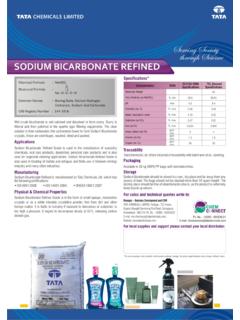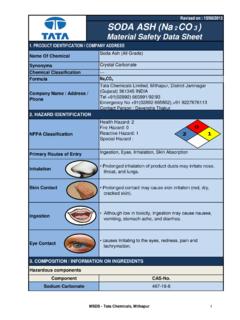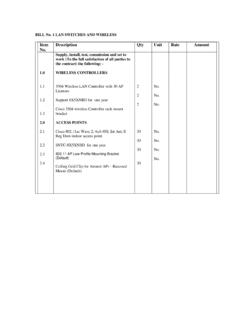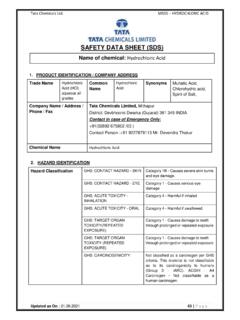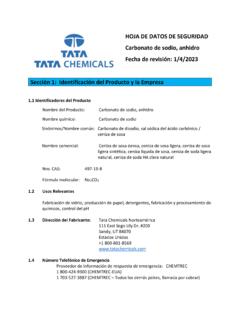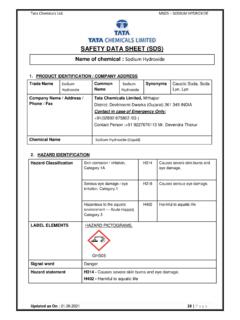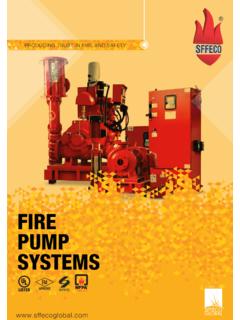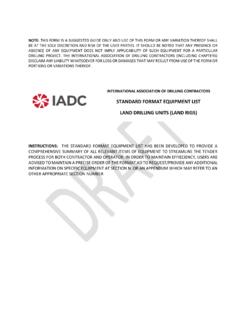Transcription of (A) SCOPE OF WORK IN MAINTENANCE OF FIRE FIGHTING …
1 (A) SCOPE OF WORK IN MAINTENANCE OF fire FIGHTING EQUIPMENT Our service teams must ensure that: They have full details of the customer being visited, the location and service documents. They have all the necessary tools, spares and refills needed to enable them provide the service required. Proper code of dressing protective gear(PPE) if necessary and identification as provided by the company On reaching the customer s premises, proper introduction and identification must be done. Our service teams also have the responsibility to create good working relations with the clients.
2 Any major challenges arising should be communicated to supervisors and managers. (B) FIELD EQUIPMENTS & SYSTEMS In the field, we have various equipment s and systems. These are identified as follows; Portable fire Extinguishers Those less than 25kgs gross weight. Trolley fire Extinguishers These are wheeled trolleys normally 25kgs and above. Hose Reel System Pressurized water system with pipe network and reservoir tank. Hydrant System Manual system that provides huge volumes of water for big fires Sprinkler System Fixed automatic fire FIGHTING system. fire Alarm System An effective means of giving warning in case of fire .
3 fire Suppression System Capable of detecting, giving warnings and suppressing/ putting off fires. Very ideal for computer server rooms / data centers, Electrical switch rooms etc. (1) PORTABLE fire EXTINGUISHERS Portable fire Extinguishers are equipments which do not exceed 25kgs. They come in two Types: Pressurized and Cartridge operated. Stored pressure The pressurizing agent is dry gas nitrogen stored within the body of the extinguisher. Cartridge operated This is the case where the expellant agent, usually carbon dioxide is stored within its own metal casing and the pressure is released on actuation of the valve as the cartridge is pierced.
4 The different types of portable fire extinguishers are as follows; Water Type: Extinguishing agent is water Foam Type: Extinguishing agent is water mixed with foam Dry Powder: Extinguishing agent is dry powder potassium &sodium bicarbonate Carbon dioxide: Extinguishing agent is carbon dioxide gas GENERAL CHECK- UP FOR ALL PORTABLES Dust All equipment s must be well dusted. Paint A standard color has to be maintained. A coat of paint is recommended and especially where equipment s are kept in adverse weather conditions. Corrosion Rust and corrosion is an indication of equipment having become old and weak and may not withstand operating pressure.
5 Great care must be observed on those weak points as these areas might have holes. In this case, the extinguisher must be condemned, removed from site and replaced with a new one. Operating Instructions All equipment s must have a clear instruction label on the front side indicating how one is supposed to use the equipment in case of fire . Old torn labels must be replaced. Wall Mounting-Loose hanging extinguishers are very dangerous and may cause injuries. Wall fixing bracketsmust be securely mounted. Sealing-All extinguishers must be sealed after every certified service. Safety pin / Cap / Clip-Every extinguisher must have a safety pin, clip or cap.
6 MAINTENANCE PROCEDURE Stored Pressure Extinguishers This type of extinguisher which is pressurized should not be opened in the field unless one has confirmed its empty and one has the refilling gear for it. Confirmation should be made by physically checking the pressure gauge. If it s found non- operational, refilling should be done in the workshop. Check the gauge position; turn the cylinder upside down several times to check the condition of the powder. Extinguishers which are found to be faulty and therefore not refillable are condemned and we recommend replacement and destruction of the used ones.
7 For normal service, the general check-up procedure is followed for all extinguishers as well as checking the gauge to ensure it is in the correct location. The gauge is a circular glass faced instrument on the side of the grip valve, which has three levels starting from 0 to about 18 bars. It is red in color at the left side level. When the pointer is at this level, it means that the extinguisher is empty or under charged and therefore needs pressurizing. The middle level is green, which indicates the extinguisher is okay. The third position is red. At this point, the equipment is overcharged which is not recommended.
8 On other extinguisher models you may find the gauges located on the cylinder body. If you find the cylinder empty and you are not carrying the filling gear, taking it to the workshop is advised. Cartridge Type Extinguishers Follow the general check-up for all extinguishers. Other procedures will involve opening the extinguisher to get access to the internal parts of the cylinder Cartridge, which holds the pressurizing agent and siphon tube which releases the extinguishing agent. You will also note the level of the extinguishing agent. Check on the weight of the cartridge, which is normally indicated on the body as full,empty and content weight.
9 An exchange with a charged one is required if content weight is 10% less. Water type cartridges are coated to rust and corrosion. Check whether the siphon tube and discharge hose are blocked by blowing through. Check that all the moving parts are free and well lubricated. Seals should also be in order. Broken or worn out seals should be replaced. Foam Extinguishers The service procedure for Foam extinguishers is the same one used for Water type. The major difference is the extra chemical added to the water in a 9 Litre cylinder. The ratio of water to foam chemical is 8:1 There are various types of foam chemicals used in the field though the most common we have is AFFF (Aqueous Film Forming Foam 6%) which is clear in color.
10 Dry powder Extinguishers These come in various sizes; from to 12Kg. Normal general service procedure should take place first. The extinguishing agent is a fine ground powder which comes out freely on discharge. Once exposed to the moisture or after several years without service, it tends to cake together and this makes it difficult to discharge as it will block the siphon tube and discharge hose. Caked powder should be completely replaced. In both pressurized and cartridge types, the most important thing is to ensure that the powder inside the cylinder runs freely. This is done by turning the cylinder several times upside down.
